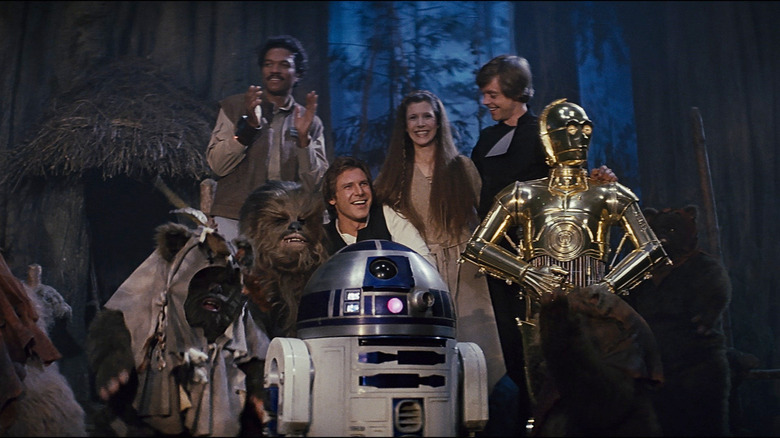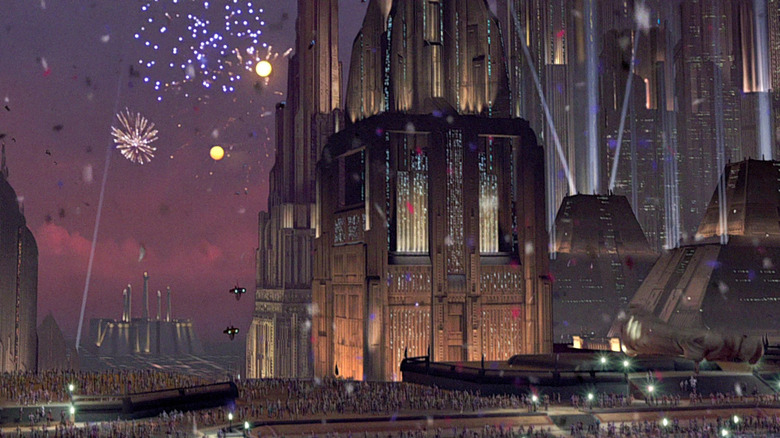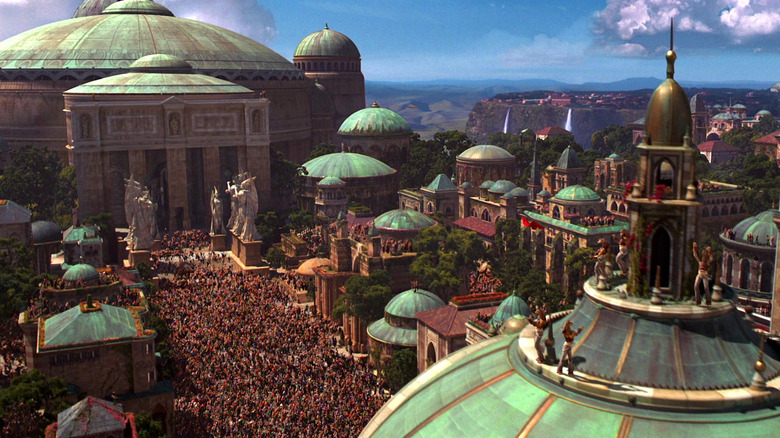Return Of The Jedi's Victory Celebration Is The Best Change Lucas Made To The Original Trilogy
Few things are as controversial in blockbuster movie history as George Lucas' "Star Wars" Special Editions. In an attempt to use new technology to bring Lucas' vision to life, the Special Editions introduced several changes that got a, shall we say, lukewarm reception — from Han and Greedo's encounter to replacing practical effects with CGI and even replacing entire actors.
Many of these changes were bad and have aged poorly, but some were rather good. For instance, the Special Edition of "Return of the Jedi" gave us without a doubt the best addition to the original trilogy and a John Williams banger. I'm talking about the Victory Celebration montage, which takes place at the very end of the movie. In the original cut (which audiences could have easily been spoiled for ahead of time), after blowing up the second Death Star, the Rebels celebrate with the Ewoks in a relatively small party that's more about the gang completing a mission than anything else. We get Luke cremating his father's body and seeing the ghosts of Anakin, Obi-Wan, and Yoda before going back to Endor's hottest club, because no one wants to miss the Ewoks singing "Yub Nub," their cute tribal party song.
Both the Special Edition and the 2004 DVD version of the film make changes to this ending. The result is not only a great conclusion to the original trilogy, but in a world where we have "Star Wars Rebels," "Rogue One," and "Andor," this is the perfect ending for this era in the history of the Rebellion and the greater Skywalker Saga.
A galaxy-wide celebration
The new ending cuts away from Luke cremating Vader (just as the Ewoks kick off their festivities) to shots of citizens celebrating on Bespin, Tatooine, and Coruscant (with the 2004 DVD release also adding Naboo to the mix). "Yub Nub" was replaced with a John Williams melody, "Victory Celebration," which is the icing on the cake for this ending.
The original celebration was perfectly fine as a fairy tale ending to the fantasy story George Lucas was telling. We saw the main Rebel forces and the Ewoks celebrating, with the tribal sounds of "Yub Nub" and the low-key party fitting the idea of the primitive Ewoks defeating the futuristic Empire. But the new version is so much more. For starters, Williams' score is rousing, victorious, the culmination of an epic conflict, with the montage serving as a coda to the Rebellion. The short shots of people celebrating are the only times in the original trilogy that we see how the general public reacts to the Rebellion and get to watch them cheer the Rebels on.
At the time, it made sense we didn't see more of this. There's simply not enough room (or budget) in the original trilogy to pull the focus away from the main storylines to show what random "Star Wars" citizens are doing elsewhere. The result made the war against the Empire look relatively simple, almost easy.
Over the past decade, however, Lucasfilm has turned its attention to the years before the destruction of the original Death Star and the first major victory of the Rebellion. Movies like "Rogue One," shows like "Rebels" and "Andor," video games like "Fallen Order" and "Jedi Survivor," and even the entirety of the prequel trilogy have shown that the path to victory was no fairy tale.
A cathartic and poignant coda
Just like "Rogue One" made the destruction of the original Death Star more poignant by showing us the daring sacrifice that had to be made to achieve that victory, and just as the prequels and "Clone Wars" giving us the full picture of Anakin Skywalker's tragic fall made his redemption all the sweeter, the Reign of the Empire era of "Star Wars" made the death of the Emperor and the Victory Celebration montage all the more emotionally-charged. By now, we have seen firsthand how cruel and oppressive the Empire was and how much pain they brought to the galaxy.
We also know how hard it was to mount a resistance, how much suffering and pain was brought on by the Imperials, and how many lives were lost in the struggle. To see the Empire suffer knowing they are the bad guys is one thing, but seeing them defeated once and for all after the events of "Rebels," after Order 66, after "Andor" drew parallels to the real world, and after the riots on Ferrix and Narkina 5, is cathartic. What really sells the montage as a victory, however, is seeing regular citizens celebrate or even rise up as they do on Coruscant, where they tear down Palpatine's statue. This scene makes the Galactic Civil War truly feel galactic.
"Return of the Jedi" has such a perfect ending that they essentially replicated the whole thing in "Rise of Skywalker," only much worse. Lucas' Special Edition continues to be controversial, but the Victory Celebration montage alone was worth every bad change.


